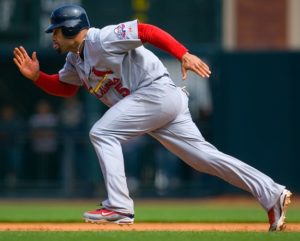Courtesy runners are used at many levels in baseball, from travel and high school ball to adult and senior leagues. The places where courtesy runners are not allowed are the collegiate and professional levels. Major League Baseball is the one place where courtesy runners would seem to make sense to help prolong the careers of heavy hitters like David Ortiz and Albert Pujols.
A courtesy runner is a player who comes in to run for a teammate on base. Depending on individual rules, a courtesy runner may have to be a player not already in the batting order. A courtesy runner may have to be in the batting order. Many times the rule in place is that the last batted out is the designated courtesy runner.
 While courtesy runners are used in adult leagues because players are older (more fragile), there is a case to be made for courtesy runners in MLB. Ortiz retired after a career year at the plate in which he set a personal high for doubles and finished 6th in MVP voting. The main reason he retired was because the pain he had in his feet and his inability to move favorably on the field. That is why he was hitting so well: he didn’t have to run to hit.
While courtesy runners are used in adult leagues because players are older (more fragile), there is a case to be made for courtesy runners in MLB. Ortiz retired after a career year at the plate in which he set a personal high for doubles and finished 6th in MVP voting. The main reason he retired was because the pain he had in his feet and his inability to move favorably on the field. That is why he was hitting so well: he didn’t have to run to hit.
There’s no telling how well Ortiz would have hit if he kept playing, but imagine if he could focus solely on batting practice and have a courtesy runner every time he got on base. I would expect Big Papi would be in favor of giving it a try if it could have given him another few years in Boston. He already was a benefactor of the American League and the DH rule, but a courtesy runner would just inflate his value.
The National League would not have as much a benefit from courtesy runners, aside from the ability to protect pitchers from having to run the bases. Only a handful of pitchers like running the bases and are typically not the fleetest of foot compared to position players. Managers would still pinch hit for a pitcher rather than wait for a courtesy runner opportunity.
David Ortiz is the most recent example of a big hitter who retired while still being able to hit. Pujols may be the next player to join that group, as his age will be catching up to him by the end of his massive contract in 2021. I doubt Pujols will be worth his salary at that time, but if he were able to only worry about hitting and not having to run the bases (or play the field at that point), he could find himself with another contract in Anaheim or elsewhere.
Hitting and Running
Rule 3.04 in the MLB Rulebook states: “A player whose name is on his team’s batting order may not become a substitute runner for another member of his team.”
Rule 3.04 comment: “This rule is intended to eliminate the practice of using so-called courtesy runners. No player in the game shall be permitted to act as a courtesy runner for a teammate. No player who has been in the game and has been taken out for a substitute shall return as a courtesy runner. Any player not in the lineup, if used as a runner, shall be considered as a substitute player.”
Hitting is one of the hardest things to do in sports. The great ones are hard to come by, and aching feet is a sore reason to end their careers prematurely, even if only by a few years. If courtesy runners were allowed, here are the stipulations that would be best for the Major League level.
The courtesy runner would have to be a player on the bench who has not already been in the batting order. He would be eligible to run for one player only, or the given player’s substitution. This would apply to any selected player, as AL teams would opt primarily for the DH, and NL teams would opt for catchers or first basemen.
Payoff of Courtesy Runners
The biggest impact of courtesy runners would be specialization for offense. There has been a shift in specialization in pitching with “left-handed specialists” and late relievers all throwing 95 mph and up. There has been a specialization in defense with extreme shifts, catcher-framing emphasis, and multi-positional players like Ben Zobrist.
 Courtesy runners would emphasize fast base runners and power hitters to an even greater extent. Teams already employ bats such as Chris Carter, Victor Martinez, and Matt Kemp – big bodies who provide lots of pop but aren’t likely to win any races against The Freeze. Speed is a tool primarily utilized by younger players, and courtesy runners could allow certain players to garner an active roster spot ahead of September call-ups.
Courtesy runners would emphasize fast base runners and power hitters to an even greater extent. Teams already employ bats such as Chris Carter, Victor Martinez, and Matt Kemp – big bodies who provide lots of pop but aren’t likely to win any races against The Freeze. Speed is a tool primarily utilized by younger players, and courtesy runners could allow certain players to garner an active roster spot ahead of September call-ups.
Fans don’t want to see slow base runners. They want to see fast footwork, steals, plays at the plate, and action around the base paths. That is the benefit of courtesy runners: the on-field quicker speed of the game. It could also lead to longer innings if defenses get fewer outs because of the faster runners.
All in all, things would eventually even out. There are few players who are truly a detriment to watch on the base paths, but you can’t argue that there are infinitely better options that Jose Molina or Bartolo Colon. It would take plenty of trial runs in the minors and the World Baseball Classic perhaps to convince Rob Manfred to make it a stable in the Majors. The odds are slim, but courtesy runners might be the best way for someone to play until the age of 50. You don’t need foot speed to excel at hand-eye coordination.

Leave a Reply